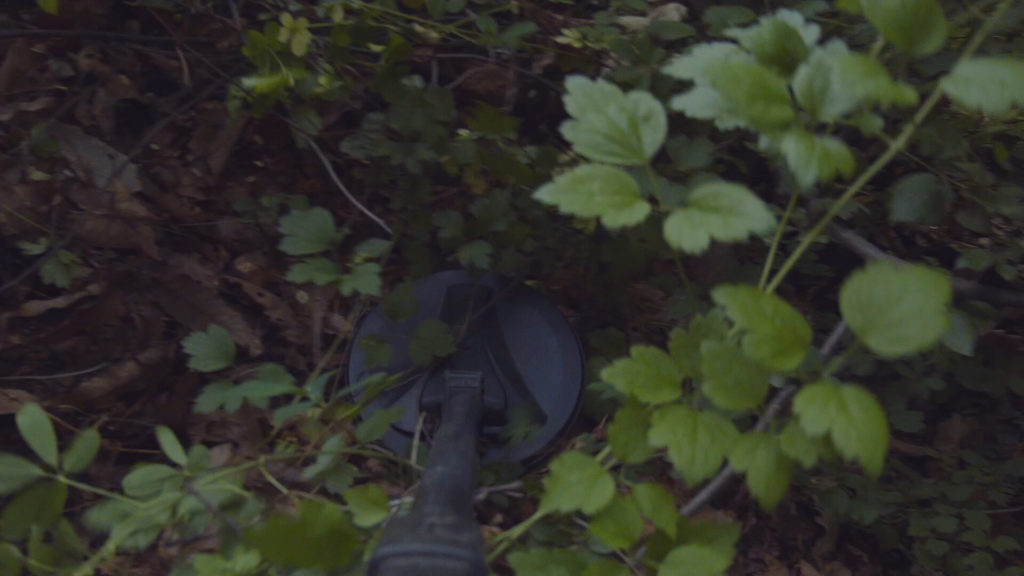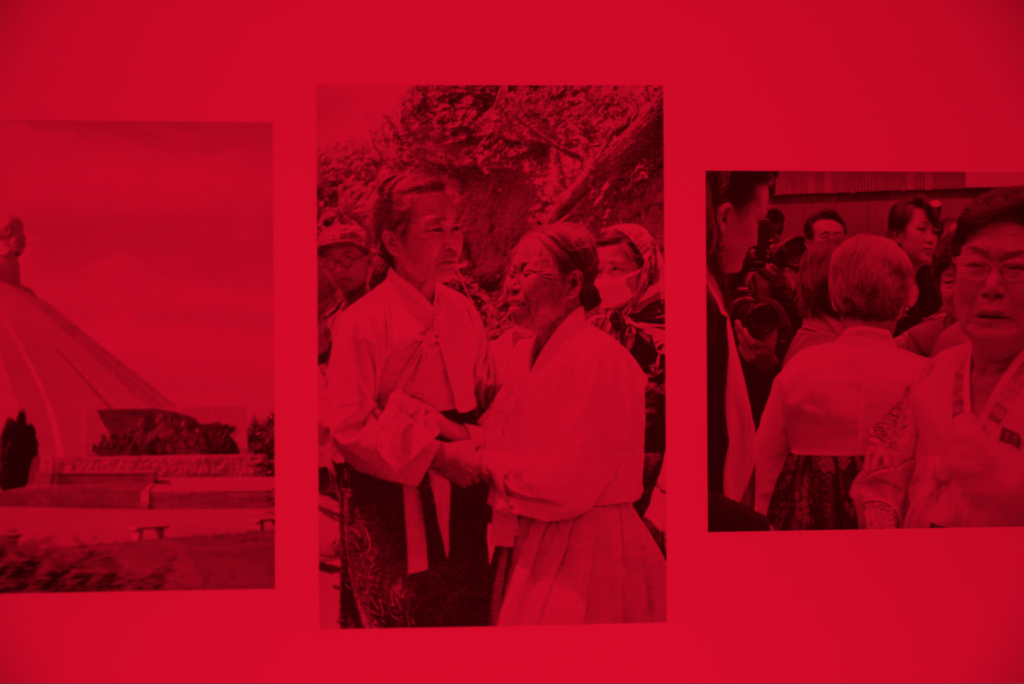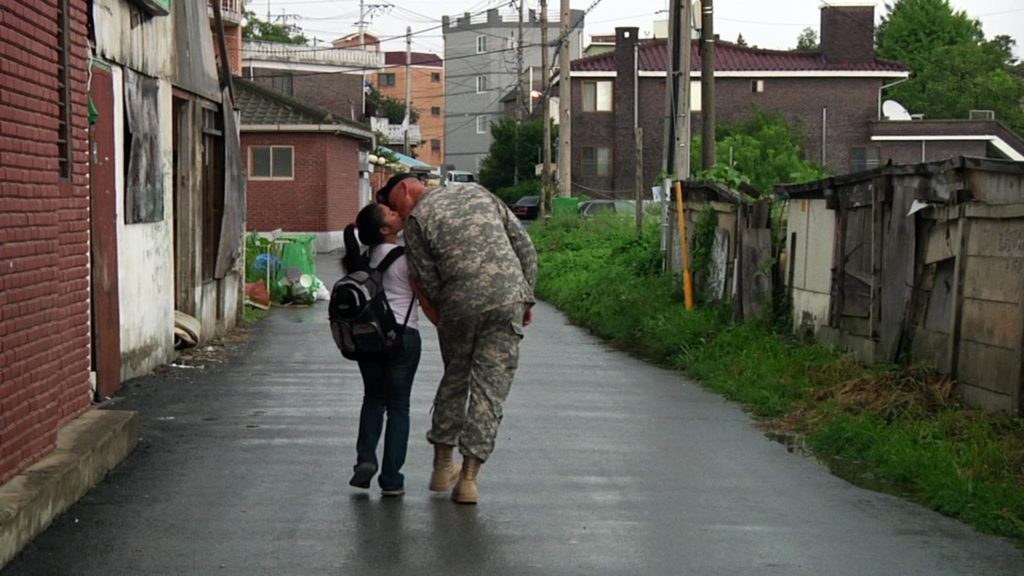

Visual artist Jane Jin Kaisen was born in Jeju Island before she was adopted at three months old. Much of her adolescence was spent in Denmark, which has one of the highest transnational adoption rates per capita. Nevertheless, it wasn’t until she returned to Korea in 2001 that she gained an opportunity to explore the complexity of the Korean diaspora through art. The 2004 Gathering was a historical event in which adoptees from around 15 countries met in the country for the first time; for many, it would be the first time that they would feel some common understanding among others who shared their respective rich experiences. Kaisen’s return to Korea became an impetus for her work that guided her throughout much of her adulthood.
Kaisen’s practice spans over 15 years of research and documentation through film, a selection of which is now at the Museum of Contemporary Art Detroit through January 30, 2022. The exhibition features her 2010 narrative experimental film The Woman, The Orphan, and the Tiger, made in collaboration with Guston Sondin-Kung, which follows three generations of women as they speak about their histories as transnational adoptees, military camptown sex workers, or former “comfort women,” culminating in a chorus of personal accounts that fights against the colonial amnesia that has erased their official histories.
Like The Woman, The Orphan, and the Tiger, many of Kaisen’s films on display focus on looking at Korea beyond border thinking. What does self-determination look like from a transnational standpoint? What have previous generations learned from each other that our generation should understand as we fight for reunification? Kaisen believes it is important to be modest about our activism and wander through our histories.
Below is a conversation with Kaisen about the importance of patience in disentangling modern Korean history, and the process behind some of her most evocative filmic work.
Lisa Kwon What motivates your work?
Jane Jin Kaisen I think mentally, it has to do with a sense of necessity and responsibility. I mean this in both a subjective and collective sense. I feel a commitment, somehow, to reflect on and understand and respond to the complexity of our times. There are certain themes that recur in my work about memory, translation, historical circumstances, diaspora, and gender issues.
Lisa Was there a personal moment as a child or a Korean adoptee that made you feel personal ties to exploring memory and how history gets written and rewritten?
Jane In some ways, [becoming] an artist and [exploring] questions of transnational adoption coincided with my entering art school in the early 2000s. That was also the time I went to Korea and it was a moment of piecing together an understanding of my own subjectivity and also the larger histories and legacies that led to the process of transnational adoption from Korea to Western countries.
In 2004, I co-founded an artist collective in Scandinavia called UFOlab, or Unidentified Foreign Object Laboratory with four other transnational adoptee women from Denmark and Sweden. It was one of the first collective artist groups of women of color in Scandinavia creating works together. This was also a moment when we were informed by the status of other artists and other social justice activists, scholars, somehow intersecting with Korea — not just transnational adoptees but also diasporic Koreans who began to return.
2004 was also a historic year in Korea because it was the first time a large number of transnational adoptees returned to Korea at the same time for the International Adoptee Gathering. This was also when several politically informed groups formed: Adoptee Solidarity Korea (ASK) and Truth and Reconciliation for the Adoption Community of Korea (TRACK). I was involved in these activities in both Korea and Scandinavia; there was an early exhibition, Rethinking Nordic Colonialism that I took part in in Scandinavia together with anti-racist scholar and activist Tobias Hübinette, that dealt with the colonial amnesia of northern Europe. The colonial legacy of Scandinavia was not really talked about at the time, so [the work] shifted my understanding both of the context that I was living in, and also the context where I was studying art. These were some early formations that really led me to explore the history and modernity of Korea.
I also studied in the U.S. afterward — first in New York, and then at UCLA — and it was a very different arts education than what I studied in Europe in terms of studying feminist and post-colonial Marxist theory, but also in terms of becoming involved in diasporic communities and communities of color in the States and understanding a different kind of history of civil rights movements in the U.S.



Sweeping the Forest Floor, 2020
Lisa At what age did you leave Korea?
Jane I was adopted in 1980 when I was three months old. I was a part of this peak generation of adoptions from Korea that happened in the 1970s and 1980s under the military authoritarian governments during Korea’s rapid economic development. It’s also really particular to be adopted to Denmark because it’s the place that has one of the world’s highest number of Korean adoptees per capita. There were not many other minorities at the time when I grew up. It’s striking in that way.
Lisa There’s a strong resistance in your work against narratives that have been driven by colonial imperialism, and you also mentioned working with different activist groups. Do you also consider yourself an activist?
Jane I certainly have affinities [for] movements for social justice. I want to be more egalitarian while working with other groups in my work so in that sense, there is a strong commitment to [activism].
I also think I should always be in solidarity. Something that I realize is that perhaps what I can do more is make a different kind of impact — a resonance through art. For me art has a lot to do with how our stories come to inform how we perceive reality and how we understand each other. I think art really has potential in shifting what are common narratives of representation forms, and somehow carving out alternative ways of understanding the reality in which we live. It’s sometimes a different kind of language from the more direct manner of activists, but I see them as related. Personally I believe I can say something different through artistic practice.

The Woman, The Orphan, and The Tiger, 2010
Lisa What was your process in finding the subjects of your different filmic work? From filming about the Jeju Island massacre to relocation of the Koryo-saram…how did you find them?
Jane Through my practice I make individual works, but many of them relate to each other. Research from one project will build into another project, so they are all correlated. When I was working on The Woman, The Orphan, and the Tiger, I was researching 20th century Korean history and issues of militarization, and then I became curious about looking towards the history of Jeju because Jeju is where my birth family is from. That is how I came to engage much more deeply with the history of the Jeju Massacre. It’s also a particular place in Korean history, a significant event for understanding the definition of Korea and the Korean War. I got to work with those issues from 2010–2011 and stayed close with different participants in truth and reconciliation movements in Jeju since then. I think that many of my works are formed around conversations and participation with people. With Koryo-Saram (members of the Korean diaspora in post-Soviet states) I met a person from Kazakhstan, Alexandra Tsay, in Seoul who had a very interesting perspective about the different experiences of dislocation and different vantage points on the Korean Peninsula. I was curious about her experience and the experience of the community that she grew up with. I think this was a mutual kind of curiosity. She is one of the narrators in my recent film Community of Parting and in the film her voice is weaved together with many other voices of South Korean, North Korean and diasporic Korean women.
Lisa With the various work and research you’ve done through film, do you have an understanding of why these stories of resistance aren’t told more often? What is the difficulty with giving them more visibility?
Jane I think it has a lot to do with power. Certain institutions have catered to certain groups of people. Usually with the people who hold societal power, there can be an unwillingness to distribute that more evenly. It can also be because once you bring those topics of resistance and forms of militarization up, you also have to ask what kind of structures are supporting the forces that keep certain people in the systems of marginalization. It becomes this mirror of oppression of society, so it’s not always so comfortable for some to look into. Of course, I think it is very important and necessary, but it’s a big continual negotiation at the moment in so many places because sociodemographics are shifting, and people who have other kinds of stories to tell would like those to be audible. I think that is why sometimes there is not more visibility. It can feel threatening to some and can feel kind of difficult to share that power and space and privilege.
Lisa I imagine it takes a lot of patience that drives long-term conversations because of that.
Jane Yes. Maybe when I was younger I was more head-on, but I think over time I learned to proceed with a certain kind of patience and humbleness. For example, with some of the people who have worked on the Jeju Massacre for decades, working toward visibility is one thing, but it is also about: What kind of society do we want to live in? How can power be distributed in a more even way, without shifting power from one group to another? In that way I guess I obtained some humbleness from talking to some of these people over time.

Apertures | Specters | Rifts, 2016

Apertures | Specters | Rifts, 2016
Lisa Among your many subjects, women have been an important focus for you. What can we learn from the women behind historic resistance moments in Korea?
Jane Something that happens when people talk about stories of resistance is that sometimes it can be hard to know what previous generations used to think because that’s not included in official histories. So you have to kind of begin anew. I think there’s a really great importance to deeper historical understanding and recognition of what previous generations were also struggling for.
One of the things I’ve been looking at is the fascinating history of the Jeju women divers and their anti-colonial resistance. They have worked under very intense, tough conditions not just physically and mentally, but also within a patriarchal structure. But they were able to create very strong ties to each other that were formulated around a different kind of socioeconomic society from society at large. It’s a codependency and co-reliance with a lot of trust when you go diving together.
I think I go back to many of their conversations now because we’re facing this climate catastrophe and some of the issues we’re facing really also have to do with the necessity of changing our mindset. Maybe something to be learned is this practice of humbleness towards your surroundings, nature, and other cohabitations, where you don’t take more than what you can afford in terms of farming the sea. Don’t expect too many resources. You have to let the sea and nature heal. I think this sort of way of being with others and the natural environment is something that is very important at this moment.
Lisa Particularly in Korea, collective memory has so much power against officially written history. Looking ahead, what can be done to advance self-determination in Korea?
Jane It’s a good question. I’m always a little bit wary about — specific to national self-determination — clearly recognizing how the Peninsula has been since the formation of North and South have been under such heavy influence and imposition from the United States, China, the Soviet Union and Japan. There is this necessity to disentangle from alliances and the mindset that militarism is predicated upon, but at the same time it is important to think about how that could be done in a way that doesn’t turn into nationalism and create new kinds of binaries and forms of exclusion. I’m curious about forms of collective memory that actually build affinities across borders, forms of radical solidarity and somehow speak to different regional alliances and different transnational and intergenerational alliances.
For MOCAD, while talking about transnational women delegations, I was thinking about these moments where forms of international solidarity across borders can be built. Our movements for self-determination can be configured around something else besides a national entity. That has been an impetus in thinking about how to do away with these forms of border thinking — not only removing the DMZ, but also the borders that are everywhere else in society, such as gender bias, racism, or class hierarchies.

The Woman, The Orphan, and The Tiger, 2010
Lisa Why tell through film and photography?
Jane Time-based media like film and video installations are really multi-sensorial media where you can work with sound, image, time, rhythm, and also space when it’s an installation. Especially because a lot of my work deals with actually connecting the different times and spaces, there’s something about the medium having a special ability to pull together these different layers. Also you can really work with several kinds of registers, like sensorial, performative, and cognitive registers. The Woman, The Orphan and the Tiger is an experimental film that really oscillates between something that is more interview-based to something that is quite performative, poetic and multi-vocally driven.
I think that film as a medium also has a relation to memory because film is essentially about time and a connection to lived experience. There’s something about the medium itself that carries an intrinsic potentiality for addressing questions of diasporic reality and how times and spaces are fragmented.
Lisa What keeps you in Copenhagen?
Jane At this moment I’m a professor at The School of Media Arts at the Royal Danish Academy of Fine Arts in Copenhagen. It is a different kind of challenge to be teaching, and that is one of the reasons I stay. Something that I see while working with students is that it is related to what my generation was working towards in the early 2000s. That whole dialogue and discourse is in a different place now though. It’s not necessarily easier. In some ways it’s more difficult, or there are different kinds of challenges. But I can also see how the younger generation today is much more informed, has a much more elaborate language, and is much more connected than we were. It’s quite inspiring to observe that.
Lisa How did you land on “Parallax Conjunctures” as the name for your exhibition at MOCAD? It’s a very technical name.
Jane It’s quite technical, it’s kind of funny. I was thinking about my earlier work “Apertures | Specters | Rifts” and how I was curious about aperture referring to the eyes and sense of sight in an almost scientific way. I think about parallax in a similar sense. It has to do with the placement of your position and relation. You perceive [an object] differently from different positions, but the object is the same. I was thinking about that in relation to the DMZ. “Apertures | Specters | Rifts” was based on the DMZ crossing and my travel to North and South Korea in 2015. I was dealing with this question of borders, so I think that’s how the title somehow came about.
A recognition of what you perceive has a lot to do with your position in relation to something in a way that is sort of an objective viewpoint. It is somehow between oneself and the object in mind. I think that was my experience of the border. It can be something that is extremely abstract to some, and to others, it can be something incredibly tangible, violent and visceral.
Museum of Contemporary Art Detroit through January 30, 2022

